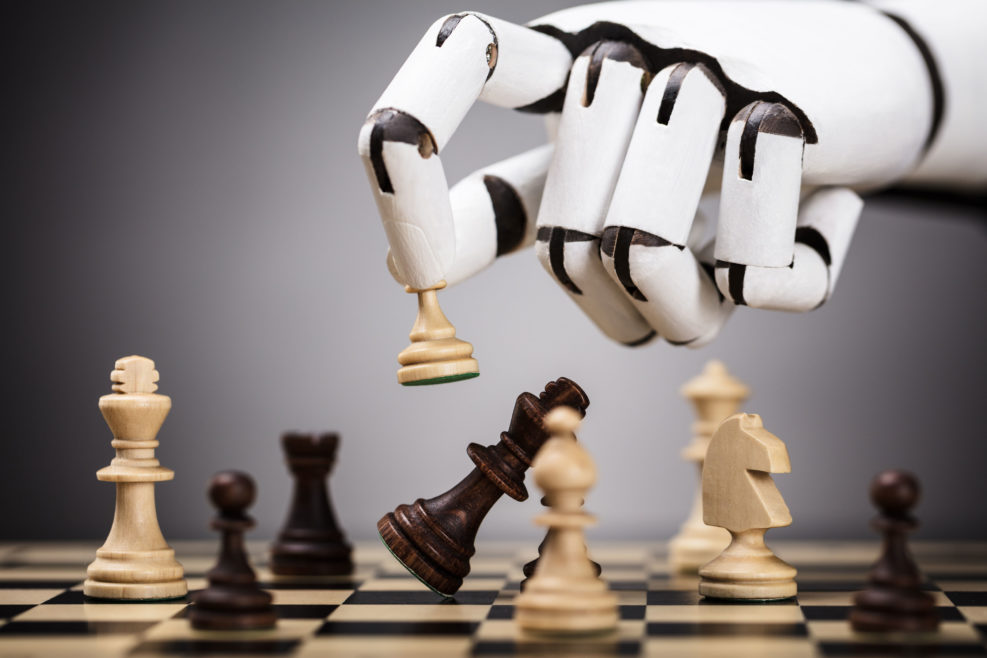
Monthly Archive June 2021


Is More Coercion — in Principle — an “Extension” of Morality?
Activist Garrett Hardin popularized government coercion to “save the planet” in 1968Recently, the Communist Party of China has announced permission for the three-child family, possibly because of the demographic ruin that the previous one-child family has occasioned in that country. But the basic idea that government should control everything is not new and it did not originate in China. Let’s go back to the 1960s in the United States. In 1968, Garrett Hardin (1915–2003) made a famous appeal in the American Association for the Advancement of Science’s magazine, Science, for good old-fashioned coercion of human beings to stop having so many children: The abstract for his “Tragedy of the Commons” (Science, 1968), a Cool concept at the time, read simply “The population problem has no technical solution; it requires a fundamental Read More ›

Richard Dawkins is not just ableist, he’s unscientific
He refuses to see the joy that people with Down Syndrome bring into the worldOriginally published on MercatorNet on June 2, 2021 by Ann Farmer Way back when, one of life’s great certainties used to be that no matter how obnoxious, prejudiced, jaundiced or snooty Richard Dawkins, the Grand Poobah of Atheism, was, the accolades would continue to roll in. Alas! Those were the Good Old Days for poor old Richard. Nowadays he is looking more and more like a bewildered T-Rex the day after the Cretaceous extinction event. Earlier this year Richard was cancelled by the American Humanist Association. It revoked his 1996 humanist of the year award because he had expressed scepticism about trans people in one of his recent tweets. It turns out that Richard needed his mouth washed out with soap Read More ›

The Mystery of Numeracy: How DID We Learn To Count?
Some animals can do rough figuring but only humans countAt a time when many people see numbers, arithmetic, and mathematics as mere oppression, others are intrigued by the basic question, how did the human race learn to do math? There are some clues, as a new project called Quanta is trying to establish. First, while no animals use abstract numbers in the wild, some animals can do rough figuring: Although researchers once thought that humans were the only species with a sense of quantity, studies since the mid-twentieth century have revealed that many animals share the ability. For instance, fish, bees and newborn chicks can instantly recognize quantities up to four, a skill known as subitizing. Some animals are also capable of ‘large-quantity discrimination’: they can appreciate the difference Read More ›

New Paper Provides Further Evidence for Free Will
According to the new research, many of the busy brain signals on which the “no free will” position depends on were system noiseWe all sense that free will is real. We know that we could have stopped ourselves from making some mistakes. For decades, some neuroscientists have claimed that free will is an illusion, based on some well-publicized experiments. Some recent research challenges that: Experiments spanning the 1960s and 1980s measured brain signals noninvasively and led many neuroscientists to believe that our brains make decisions before we do—that human actions were initiated by electrical waves that did not reflect free, conscious thought. However, a new article in Trends in Cognitive Science argues that recent research undermines this popular case against free will. “This new perspective on the data turns on its head the way well-known findings have been interpreted,” said Adina Roskies, Read More ›

A Wrinkle In Time: Reading Science Fiction At An Early Age
An early introduction to science fiction will be a boon to any child's imaginationWhen I was young, my father was constantly pressing new books into my hands. The first in remembrance was C.S. Lewis’s The Lion, the Witch and the Wardrobe. The second to stand out was Madeleine L’Engle’s A Wrinkle In Time. It was a funny choice, really. My father’s theology does not match L’Engle’s universalism, nor are his preferred subjects math and science. At the time, I was unable to wrap my mind around concepts of dimension and time introduced by L’Engle, but the novel became a fast favorite that I have returned to in my adulthood. A Wrinkle In Time was most recently brought back into popular view when an adaptation imagined by director Ava DuVernay was released in theaters Read More ›

“Are We Alone?” Asks a New Sci-Fi Short. But Then Why?
In “Laniakea,” we are introduced to a civilization’s – museum? Or what is it? An intriguing Sci-fi Saturday“Laniakea” at DUST by Dima Taran (November 13, 2020, 5:48 min, animated) “The action takes place in the future, when superluminal speeds allow for travel to any point in the universe. People are hoping to find extraterrestrial life, but as of yet no one has succeeding in finding anything. One day, a lonely man finds a message in a monolith that has been drifting in space. It helps him to find a portal that leads to the home planet of those who made the monolith. He finds a giant structure, a building. But …This place is breathing on its own. Where has everyone gone?” Review: Good graphics and animation, in the service of a sobering point. The aliens could have Read More ›

If It’s Real, It Must Be Endured. – Sci-Fi Saturday
“It’s Okay?”, using futurist technology, takes a woman back through her time with someone she loves.“It’s Okay” at DUST by Justin Giddings and Ryan Welsh (June 3, 2021, 8:47 min) In this Black Mirror-esque tale, a couple revisit key moments of their past, only for their memories to take an unexpected turn. … Cam and Alex are a simple couple living an un-extraordinary life, when strange things suddenly start happening to them. Will they uncover the truth before they lose one other? Review: This is a remarkably well done short film. The directors are in control of their plot. If you don’t entirely understand what is happening at first, you will later. And that’s no easy task when the very proposition of the story involves bending time. The human mind is structured to understand time Read More ›

Do You Have a “Selfish Prefrontal Cortex”?
Do you tell “white lies” only for selfish motives?A recent neuroscience paper claims to determine whether your motives are selfish: You may think a little white lie about a bad haircut is strictly for your friend’s benefit, but your brain activity says otherwise. Distinct activity patterns in the prefrontal cortex reveal when a white lie has selfish motives, according to new research published in Journal of Neuroscience. White lies — formally called Pareto lies — can benefit both parties, but their true motives are encoded by the medial prefrontal cortex (MPFC). This brain region computes the value of different social behaviors, with some subregions focusing on internal motivations and others on external ones. Kim and Kim predicted activity patterns in these subregions could elucidate the true motive behind Read More ›

Is the Key to Human Language To Be Found In Singing Birds?
If singing birds can explain human speech, why aren’t the birds all giving interviews?That’s the claim of a recent article in Cognitive Sciences: The study is based on evidence from diverse fields such as archaeology, evolutionary genomics, neurobiology, animal behaviour and clinical researcher on neuropsychiatric disorders. With these, it shows that the reduction of reactive aggressiveness, resulting from the evolution and process of self-domestication of our species, could have led to an increase in the complexity of speech. According to the authors, this development would be caused by the lowest impact on brain networks of stress hormones, neurotransmitters that activate in aggressive situations, and which would be crucial when learning to speak. To show this interaction, researchers analysed the genomic, neurobiological and singing-type differences between the domesticated Bengalese finch and its closest wild Read More ›

“AI is fastest path to Communism,” says Elon Musk’s partner
In a viral TikTok video, the singer/songwriter said AI will lead us to a world of leisure and no workSocial media was aflood yesterday with confusion and intrigue when Grimes – a Canadian singer/songwriter and 3-year partner to technological entrepreneur Elon Musk – said that “AI is actually the fastest path to communism” and encouraged communists to embrace the technology if they want to see their political dreams come true. Grimes (born Claire Elise Boucher) posted a short video to TikTok on Thursday, proposing that artificial intelligence could lead us to a utopia in which no one has to work and everyone lives in leisure: “I have a proposition for the communists. So, typically most of the communists I know are not big fans of AI. But if you think about it, AI is actually the fastest path to Read More ›

How Marvin Minsky Inspired Artificial Neural Networks
And what Minsky said when a scientist seeking to further develop the field finally met himDr. Paul Werbos calls it “a soap opera you wouldn’t believe”: the story of how a young Werbos was inspired by the pioneering computer scientist to pursue the development of artificial neural networks, and how Minsky later could not support the effort for disbelief that there was a solution to its many problems. In this week’s podcast, Dr. Robert J. Marks interviewed Dr. Paul Werbos, famous for his 1974 dissertation which proposed training artificial neural networks through the use of a backpropagation of errors. The two discuss Werbos’s journey in the development of artificial neural networks and the role Marvin Minsky played throughout. This portion begins at 04:25. A partial transcript, Show Notes, and Additional Resources follow. Robert J. Marks: Read More ›

Big Tech Scrubs Religious Radio Show From YouTube
This isn't the first time YouTube has infringed on free speechYouTube removed an entire radio show from its platform this week, hosted by popular Christian author and social commentator Eric Metaxas, citing violations of their community standards. Metaxas – author of biographies on the lives of Dietrich Bonhoeffer, Martin Luther, and William Wilberforce, among many other books – announced the news to his social media pages on Tuesday. “It’s happened,” he wrote on his Facebook page. “Despite our going FAR out of our way to comply with their arbitrary ‘community standards’, YouTube decided to remove every single video we’ve ever done on the Eric Metaxas Show off their platform.” The Eric Metaxas Radio Show, humorously called “The Show About Everything”, has featured a host of big name guests, including former Read More ›

Can AI “Translate” Animal Languages Into Human Languages?
If we understood animal communications better, would they even seem like a language?That’s the question science writer Philip Ball, author of The Modern Myths: Adventures in the machinery of the popular imagination (2021), posed recently at The New Yorker. If a dolphin could talk, could we really understand its very different life experiences? Ball reports that some researchers are trying to translate dolphin communications (“dolphish”) into English: Today, animal-translation technologies are being developed that use the same “machine learning” approach that is applied to human languages in services such as Google Translate. These systems use neural networks to analyze vast numbers of example sentences, inferring from them general principles of grammar and usage, and then apply those patterns in order to translate sentences the system has never seen. Denise Herzing, the founder Read More ›

Chicken Little AI Dystopians: Is the Sky Really Falling?
Futurist claims about human-destroying superintelligence are uninformed and irresponsibleThe article “How an Artificial Superintelligence Might Actually Destroy Humanity” is one of the most irresponsible pieces about AI I have read in the last five years. The author, transhumanist George Dvorsky, builds his argument on a foundation of easily popped balloons. AI is and will remain a tool. Computers can crunch numbers faster than you or me. Alexa saves a lot of time looking up results on the web or playing a selected tune from Spotify. A car – even a bicycle – can go a lot faster than I can run. AI is a tool like fire or electricity used to enhance human performance and improve lifestyles. Like fire and electricity, AI can be used for evil or Read More ›